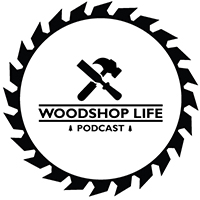This Episodes Questions:
Brians Questions:
I have a question for you about glueing up table aprons. And I’m mostly referring to large dining tables. The aprons I’m making are generally w 8/4 stock roughly 4” width. I can manage to get the legs and the aprons milled and cut square. All my joinery is w dominoes. Whenever I do the glue up everything is slightly out out square despite everything being square prior to glue up . I have pipe clamps and parallel clamps and have tried both. For some reason I can’t get the clamping pressure or positioning right. Any tips would be appreciated. Timber Tables
Hi guys!
Love your podcast and listen for over a year during my early walks in the morning. I’m always picking up a tip or two. Keep up the great work!
My question has to do with designing a bowling ball rack shelf system for my granddaughter. She is an outstanding bowler with well over 20 balls so my little ball rack is only going scratch the surface.
My plan is for a 12 ball bowling rack with three shelves with four 15# balls on each shelf. Each shelf will be made of 3/4 poplar (to be painted with college colors) and is 46” wide, 10” deep and will have 3” chamfered holes for each ball to sit in. So the shelf has to support 60# in bowling balls!
I’ll be fastening the shelves to the upright side with through tenons.
Do you guys think 3/4 poplar shelves with through tenons and chamfered holes to be enough to hold 60#? This is the first time I’ve created anything requiring that much weight to support. Any suggestions welcome. Thanks! Pappy
Guys Questions:
Hi all. Looking for recommendations for entry level laser engraver to be used for making router templates / engraving logos and simple designs on my woodworking projects such as cutting boards, wall decorations, etc. Are there any alternatives to a laser engraver that would do the same in a similar lower price point? thank you for a great show! Max
Hello gents, as always, the podcast is one of the best out there. My question for you is about pivoting. What I mean by that is, what do you do when something happens during a project that causes you to take a different direction? Recently I completed a humidor for a friend. He gave me the rough dimensions that he wanted, and his only specification was that it had some contrast and some nice looking grain. I made myself a plan and began working on making the box sides with alternating maple and cherry. My original intent was a 4 corner grain match. Unfortunately, my miters did not come out well, so I changed to a corner post design using mahogany. Since the client did not know the original plan, this was an easy change to do in my shop. Have you guys had to change your plan mid way through a project? How did you handle it and how well did it work out? As a side note, sometimes I appreciate the original plan going sideways because it forces me to think of viable alternatives.
Keep making sawdust and sharing what you love.
Joshua from The Blackdog Woodworks.
Huys Questions:
Hi guys, I have a question for the best woodworking podcast around. I bought some beautiful air dried white oak from someone who had it sitting in a barn for 20 years. I have two 4/4 boards that are 8 foot long, 10.5″ wide and almost dead straight. I would like to use them for the top of a dresser but there are several lighter shaded bands going across the boards (on both sides). I believe these stains or marks are from stickering. I did a light pass through my planer and it doesn’t appear that it made a difference. Are these boards totally ruined? I am not confident that if I keep planing them this will go away, plus they are just north of 4/4 in thickness and I was hoping to keep them as thick as possible. Jeff
Thank you for your informative podcast, enjoy the experience and diversity you bring to woodworking enthusiasts. I was recently installing drawer faces on a nightstand. The drawer boxes were just slightly inset so soft close slides would pull the drawer tight when face installed. The drawer faces are proud of the nightstand cabinet. I wanted to have very tight/consistent reveals between the two drawers and wanted the sides to line up perfectly flush with sides. This requires very precise holding of drawer fronts while securing from the back side of drawer box. I was able to get the drawer fronts flush with sides and use a 1/32 shim between drawer faces for the gap, great so far. The drawer face handle is a flat rectangular(lip style) wood pull at the top of the drawer face so there are no holes in the drawer face like there would be be with a more conventional pull. I attempted to use thin double sided tape to hold face securely in position until it could be attached but it was not secure enough to ensure the precise geometry for the drawer face until it could be attached. I felt thicker double sided tape was too flexible for desired outcome. I end up using pins strategically placed under the pull which works but the pins were barely visible. I find wood filler draws attention to pins so left them unfilled reasoning that no one would notice. My wife of course noticed right off the bat. Here is the question:
What other methods of holding drawer face in place before securing to drawer box which doesn’t leave evidence:) Thanks, Dave at xcuse4tools custom woodwork
